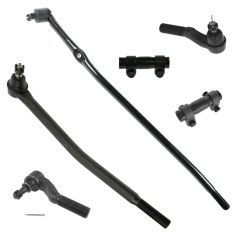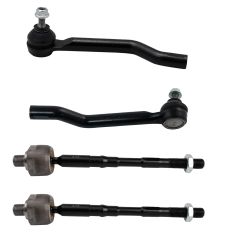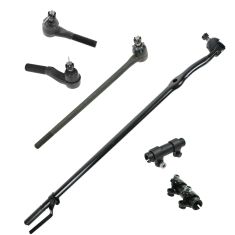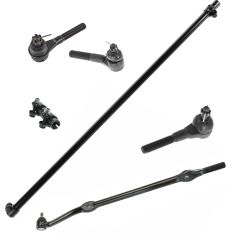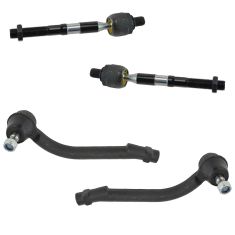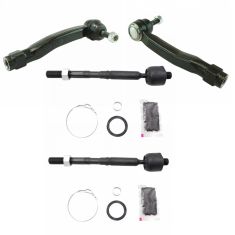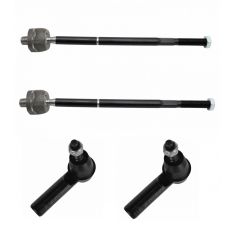Tie Rods & Adjusting Sleeves
-
-
- Air Deflectors & Valance Panels
- Battery Trays & Related
- Body Panels
- Bumpers & Related - Front & Rear
- Convertible Tops, Soft Tops, & Parts
- Decal & Stripe Kits
- Emblems & Nameplates
- Engine Compartment Trim
- Frame Parts & Bushings
- Fuel Door Parts
- Fuel Tank Filler Neck
- Grille
- Header Panel
- Hood & Hatch Lift Supports
- Hood Latch & Catch Brackets
- Hood Release Cable
- Jack Pads
- Radiator Supports
- Rust Repair Panels
- Splash Shields & Fender Liners
- Tailgate Cables
- Tailgate Hinges & Related
- Weatherstripping
-
- Car Covers
- Exterior Lighting
- Exterior Parts & Accessories
- Exterior Safety & Security
- Exterior Storage
- Fender Flares
- License Plate Brackets & Frames
- Mud Flaps & Splash Guards
- Nerf Bars, Side Steps, Running Boards
- Radio Antenna
- Rain Deflectors
- Roll Bars, Light Bars, & Related
- Roof Rack
- Skid Plates
- Spare Tire Carriers & Related
- Spare Tire Covers
- Tire Care
- Tonneau Covers
- Tow Hooks & D-Shackles
- Towing Accessories
- Trailer Hitch & Components
-
- Accelerator Pedal Pad
- Auto Carpet
- Brake Pedal Pad
- Clutch Pedal Pad
- Console Parts
- Dash Pad Cover
- Dash Vents
- Floor Mats & Liners
- Horns & Horn Parts
- Interior Parts & Accessories
- Mirror - Interior Rear View
- Seat Cover and Sets
- Seat Heater Kits
- Seat Parts and Accessories
- Sun Visors & Related
- Trunk & Cargo Parts
-
- Accelerator Pedals & Sensors
- Alarms, Control Modules, & Remote Start
- Cruise Control Switch & Lever
- Electrical Parts
- Hazard Switch
- Ignition Key Lock Cylinder
- Ignition Switch
- Keyless Entry Remote & Related
- Neutral Safety Switch
- Parking Assist Cameras & Monitors
- Power Mirror Switch
- Power Seat Switches
- Power Window Switch
- Radio, Navigation, Entertainment
- Reverse Light Switch
- Trunk Release & Lock Solenoids
- Turn Signal Switches and Levers
- Windshield Wiper Switch
-
- Idler Arm
- Pitman Arm
- Power Steering Hoses
- Power Steering Oil Cooler
- Power Steering Pressure Sensor
- Power Steering Pump
- Power Steering Pump Cooling Fan
- Power Steering Pump Pulley
- Power Steering Pump Reservoir
- Steering Dampers
- Steering Knuckles and Spindles
- Steering Rack and Gear Boxes
- Steering Shafts & Couplers
- Steering Wheels & Column Parts
- Tie Rods & Adjusting Sleeves
-
-
-
-
2826
283
10
10
-
Notify When Available
Replaces Ford Front Driver & Passenger Side Inner & Outer 6 Piece Tie Rod Set TRQ PSA55088
Brand: TRQ - PSA55088$121.95Save 26%List $163.95 Save $42.00Brand: TRQ - PSA55088$121.95Save 26%List $163.95 Save $42.00 -
Notify When Available
Replaces Nissan Rogue Rogue Sport Front Driver & Passenger Side Inner & Outer 4 Piece Tie Rod Set TRQ PSA60579
Brand: TRQ - PSA60579$74.95Save 21%List $94.95 Save $20.00Brand: TRQ - PSA60579$74.95Save 21%List $94.95 Save $20.00 -
Notify When Available
Replaces Chevrolet GMC Cadillac Front Inner & Outer 4 Piece Tie Rod Set TRQ PSA54815
Brand: TRQ - PSA54815$67.95Save 9%List $74.95 Save $7.00Brand: TRQ - PSA54815$67.95Save 9%List $74.95 Save $7.00 -
Notify When Available$104.95Save 30%List $148.95 Save $44.00Brand: TRQ - PSA58484$104.95Save 30%List $148.95 Save $44.00
-
Notify When Available
Replaces 1997-06 Jeep Wrangler Front Driver & Passenger Side Inner & Outer 6 Piece Tie Rod Set TRQ PSA55405
Brand: TRQ - PSA55405$99.95Save 33%List $148.95 Save $49.00Replaces 1997-06 Jeep Wrangler Front Driver & Passenger Side Inner & Outer 6 Piece Tie Rod Set TRQ PSA55405
Brand: TRQ - PSA55405$99.95Save 33%List $148.95 Save $49.00 -
Notify When Available
Replaces Hyundai Santa Fe Kia Sorento Front Driver & Passenger Side Inner & Outer 4 Piece Tie Rod Set TRQ PSA55333
Brand: TRQ - PSA55333$54.95Save 24%List $71.95 Save $17.00Brand: TRQ - PSA55333$54.95Save 24%List $71.95 Save $17.00 -
Notify When Available
Replaces 1999-04 Jeep Grand Cherokee Front Driver & Passenger Side Inner & Outer 6 Piece Tie Rod Set TRQ PSA55041
Brand: TRQ - PSA55041$129.95Save 24%List $169.95 Save $40.00Brand: TRQ - PSA55041$129.95Save 24%List $169.95 Save $40.00 -
Notify When Available
Replaces Toyota Lexus Front Driver & Passenger Side Inner & Outer 4 Piece Tie Rod Set TRQ PSA66759
Brand: TRQ - PSA66759$72.95Save 25%List $96.95 Save $24.00Brand: TRQ - PSA66759$72.95Save 25%List $96.95 Save $24.00 -
Notify When Available
Replaces Nissan Infiniti Front Driver & Passenger Side Outer 2 Piece Tie Rod Set TRQ PSA55442
Brand: TRQ - PSA55442$52.95Save 13%List $60.95 Save $8.00Brand: TRQ - PSA55442$52.95Save 13%List $60.95 Save $8.00 -
Notify When Available
Replaces 2011-14 Ford Mustang Front Driver & Passenger Side Inner & Outer 4 Piece Tie Rod Set TRQ PSA69695
Brand: TRQ - PSA69695$59.95Save 23%List $77.95 Save $18.00Replaces 2011-14 Ford Mustang Front Driver & Passenger Side Inner & Outer 4 Piece Tie Rod Set TRQ PSA69695
Brand: TRQ - PSA69695$59.95Save 23%List $77.95 Save $18.00
loading...
Choose the Make of Your Vehicle
